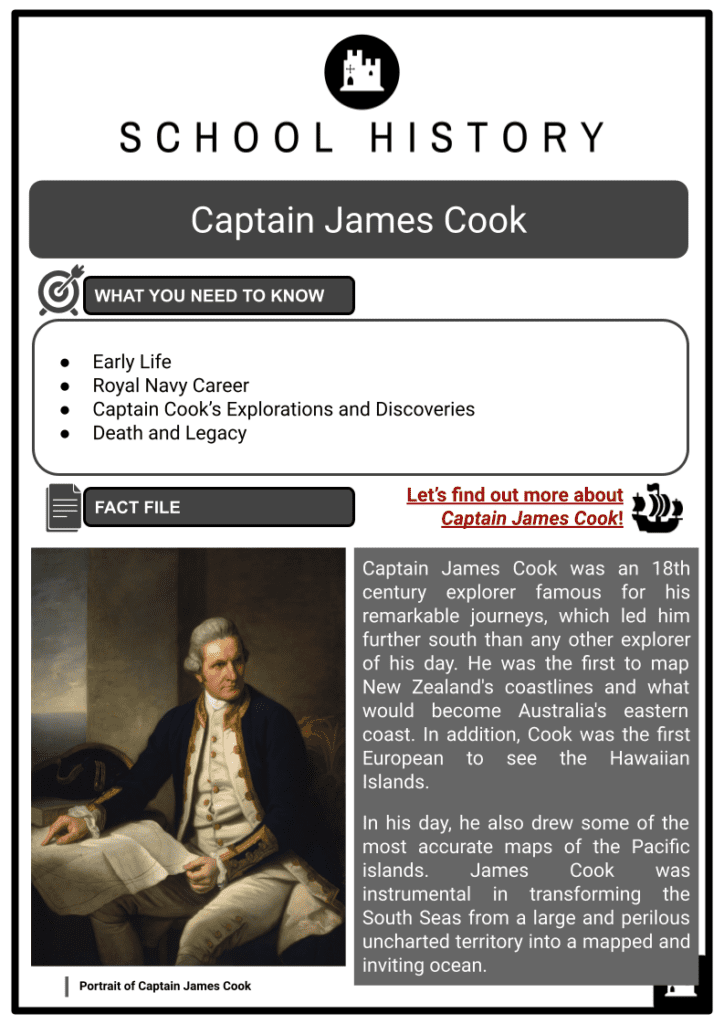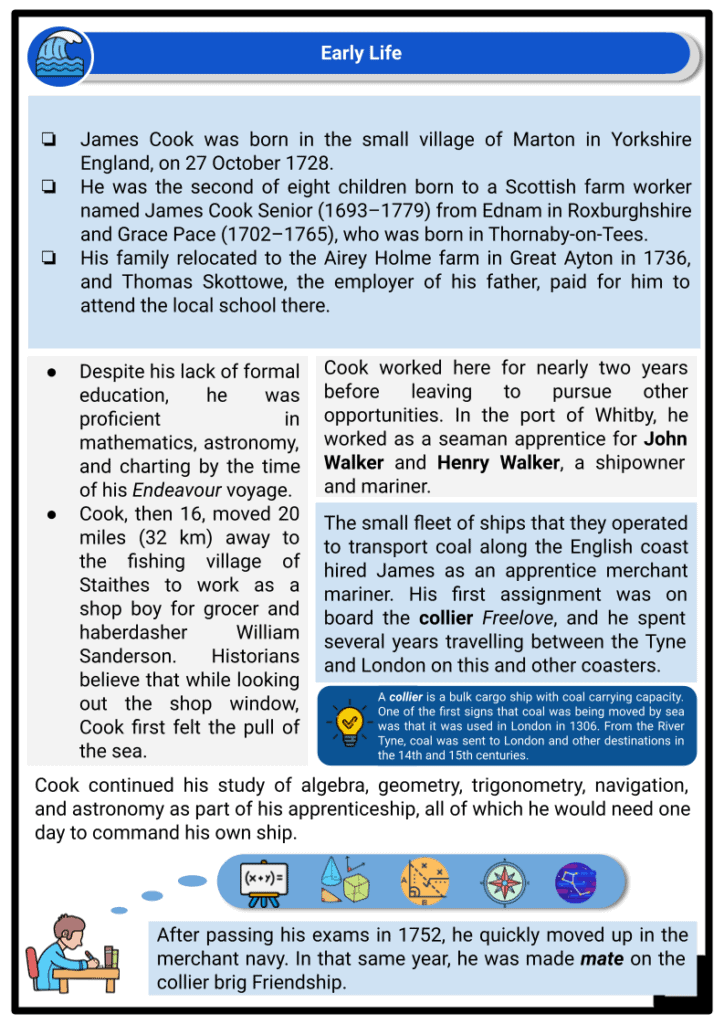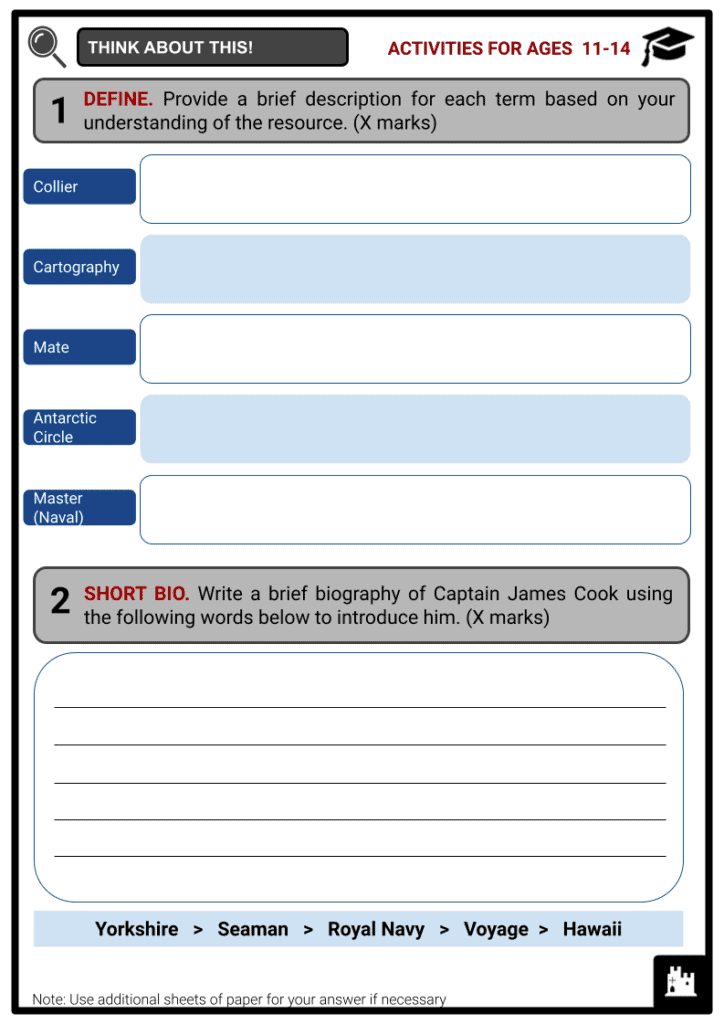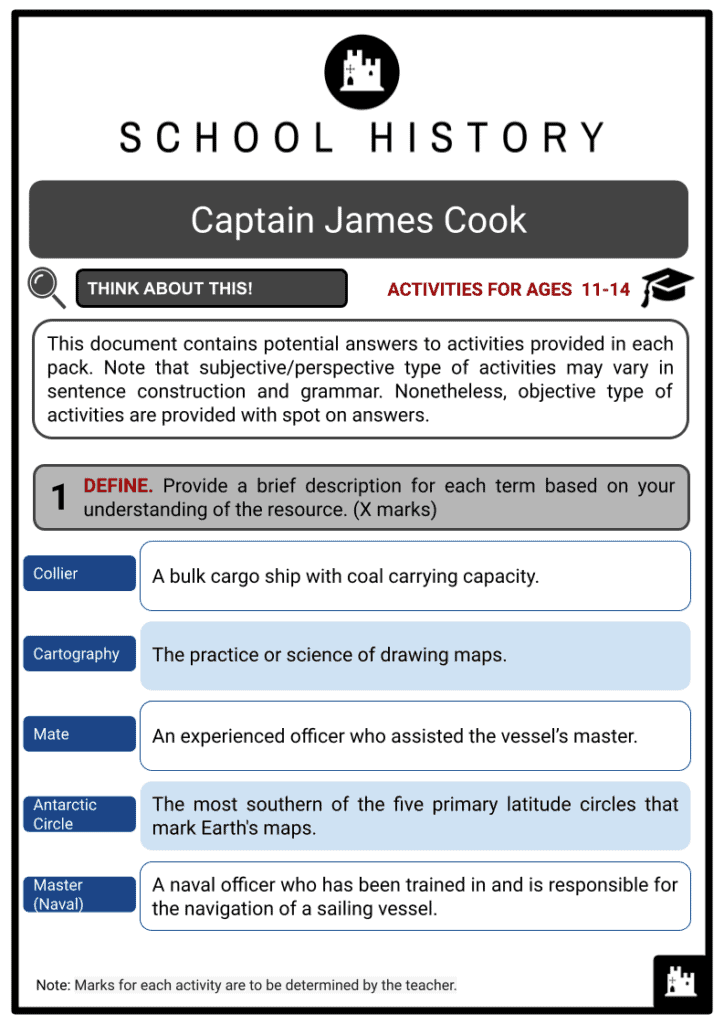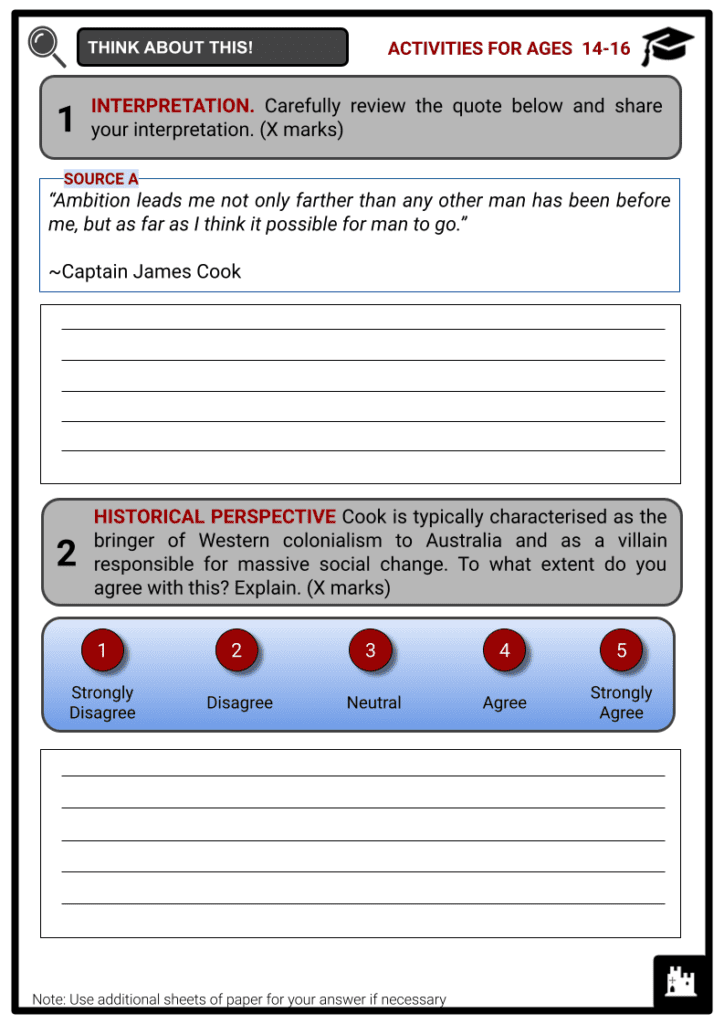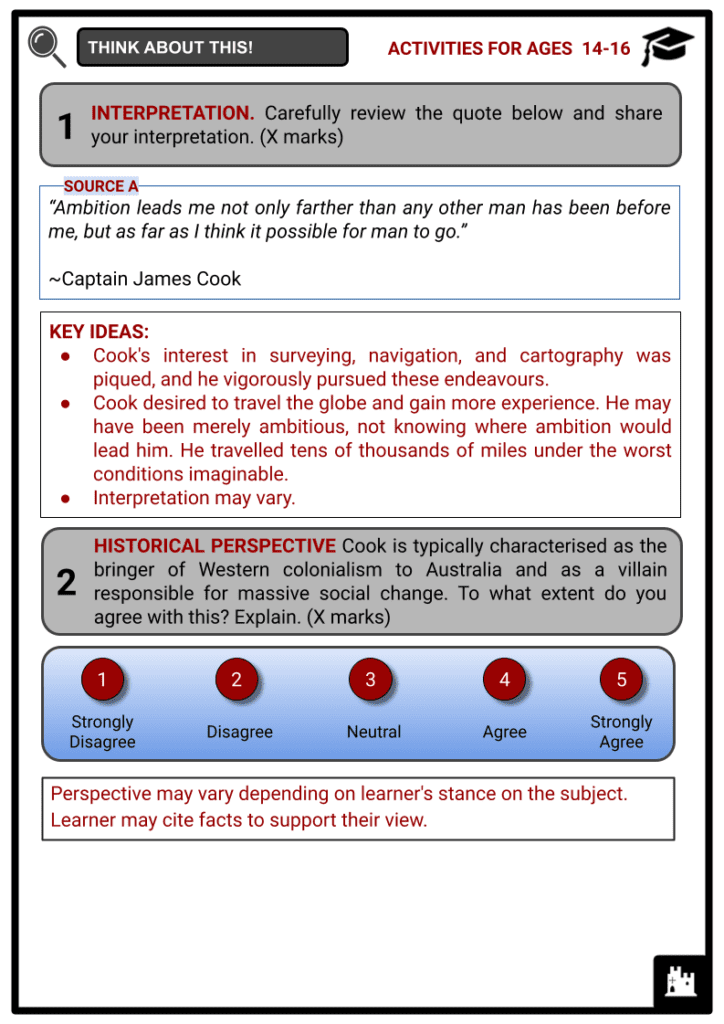Captain James Cook Worksheets
Do you want to save dozens of hours in time? Get your evenings and weekends back? Be able to teach about Captain James Cook to your students?
Our worksheet bundle includes a fact file and printable worksheets and student activities. Perfect for both the classroom and homeschooling!
Summary
- Early Life
- Royal Navy Career
- Captain Cook’s Explorations and Discoveries
- Death and Legacy
Key Facts And Information
Let’s find out more about Captain James Cook!
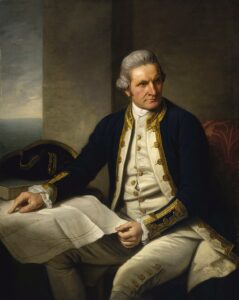
Captain James Cook was an 18th century explorer famous for his remarkable journeys, which led him further south than any other explorer of his day. He was the first to map New Zealand's coastlines and what would become Australia's eastern coast. In addition, Cook was the first European to see the Hawaiian Islands. In his day, he also drew some of the most accurate maps of the Pacific islands. James Cook was instrumental in transforming the South Seas from a large and perilous uncharted territory into a mapped and inviting ocean.
Early Life
- James Cook was born in the small village of Marton in Yorkshire England, on 27 October 1728.
- He was the second of eight children born to a Scottish farm worker named James Cook Senior (1693–1779) from Ednam in Roxburghshire and Grace Pace (1702–1765), who was born in Thornaby-on-Tees.
- His family relocated to the Airey Holme farm in Great Ayton in 1736, and Thomas Skottowe, the employer of his father, paid for him to attend the local school there.
- Despite his lack of formal education, he was proficient in mathematics, astronomy, and charting by the time of his Endeavour voyage.
- Cook, then 16, moved 20 miles (32 km) away to the fishing village of Staithes to work as a shop boy for grocer and haberdasher William Sanderson. Historians believe that while looking out the shop window, Cook first felt the pull of the sea.
- Cook worked here for nearly two years before leaving to pursue other opportunities. In the port of Whitby, he worked as a seaman apprentice for John Walker and Henry Walker, a shipowner and mariner.
- The small fleet of ships that they operated to transport coal along the English coast hired James as an apprentice merchant mariner. His first assignment was on board the collier Freelove, and he spent several years travelling between the Tyne and London on this and other coasters. A collier is a bulk cargo ship with coal carrying capacity. One of the first signs that coal was being moved by sea was that it was used in London in 1306. From the River Tyne, coal was sent to London and other destinations in the 14th and 15th centuries.
- Cook continued his study of algebra, geometry, trigonometry, navigation, and astronomy as part of his apprenticeship, all of which he would need one day to command his own ship.
- After passing his exams in 1752, he quickly moved up in the merchant navy. In that same year, he was made mate on the collier brig Friendship.
Royal Navy Career
- Within a month of being given command of the Friendship, Cook volunteered for service in the Royal Navy, just as Britain was readying for the Seven Years' War.
- Cook’s first position was with HMS Eagle, where he worked as an able seaman and master's mate for the first year he was on board, and then under Captain Hugh Palliser after that. HMS is the ship prefix used in several monarchies for navy vessels, which stands for His or Her Majesty’s Ship.
- He formally passed his master's examinations at Trinity House, Deptford, in June 1757, qualifying him to navigate and handle a ship in the King's fleet. He then became master of the frigate HMS Solebay under Captain Robert Craig. In the 1800s, the Royal Navy used a rating system to classify sailing warships. A fourth-rate ship was a ship of the line with 46 to 60 guns.
- During the Seven Years' War, Cook served as master aboard the fourth-rate Navy vessel HMS Pembroke in North America. He and other members of Pembroke's crew took part in the major amphibious assault that captured the French Fortress of Louisbourg in 1758, as well as the siege of Quebec City in 1759.
- Cook displayed a talent for surveying and cartography throughout his time in the military and was in charge of mapping a significant portion of the Saint Lawrence River entrance during the siege, which allowed General Wolfe to launch his renowned covert attack during the Battle of the Plains of Abraham in 1759.
Newfoundland
- Cook’s surveying skills were also put to use in mapping the craggy coast of Newfoundland aboard HMS Grenville in the 1760s.
- In 1763 and 1764, he surveyed the northwest stretch, the south coast between the Burin Peninsula and Cape Ray in 1765 and 1766, In 1767, he mapped the area on the west coast.
- Cook used local pilots to point out "rocks and hidden dangers" around the south and west shores during this period.
- Cook made astronomical observations while in Newfoundland, focusing on the solar eclipse of 5 August 1766.
- By getting a precise estimate of when the eclipse started and ended and comparing those timings with those at a known location in England, it was feasible to determine the longitude of the observation point in Newfoundland.
- The Royal Society was informed of this finding in 1767.
- His five seasons in Newfoundland resulted in the creation of the first detailed maps of the island's coasts at a wide scale and the first large-scale hydrographic surveys that used accurate triangulation to determine the locations of land features. Triangulation is the method of identifying the position of a point in trigonometry and geometry by building triangles to the point from known locations.
- Cook’s maps were used well into the twentieth century, with copies being used by sailors navigating Newfoundland's waters for over 200 years.
Captain Cook’s Explorations and Discoveries
First voyage (1768–1771)
- The Admiralty appointed Cook to lead a research expedition to the Pacific Ocean on 25 May 1768.
- The mission intended to observe and document Venus' transit across the Sun in 1769, which—when aligned with observations from other locations—would aid in determining how far the Earth is from the Sun.
- A transit of Venus across the Sun occurs when the planet Venus moves in close proximity to a superior planet, blocking out a small area of the solar disc and being visible against it. From Earth, a transit of Venus appears as a tiny black dot travelling over the face of the Sun.
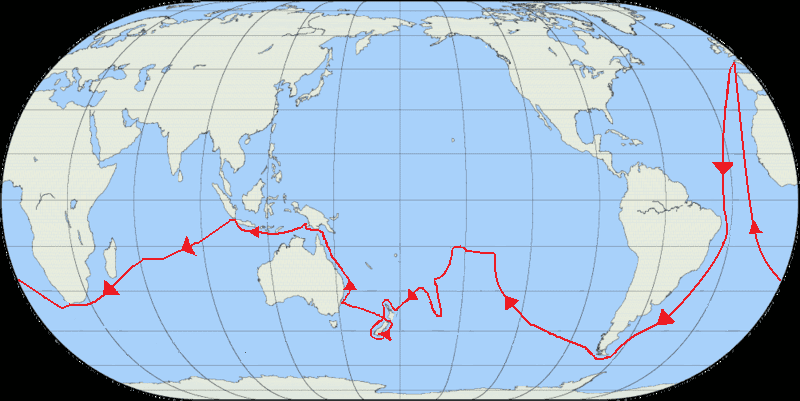
Cook's route on his first voyage - Cook was promoted to lieutenant at the age of 39, giving him the necessary standing to take command. In addition to his Naval salary, the Royal Society agreed that Cook should receive a one hundred guinea bonus.
- The voyage sailed aboard HMS Endeavour from England on 26 August 1768. Cook and his crew rounded Cape Horn and continued westward across the Pacific, arriving at Tahiti on 13 April 1769, where the observations of the transit were made.
- They collected samples of natural plants and animals while on the island.
- They also met some native people and learned about their cultures and traditions.
- Cook sailed to some of the nearby islands, including modern-day Bora Bora, documenting his route.
- Once the observations were done, Cook was given new instructions for the rest of his trip. He was told to look in the south Pacific for signs of the legendary rich southern continent of Terra Australis (the Great Southern Land). The Royal Society believed that Terra Australis must exist and that using Cook's Transit of Venus voyage would give Britain the best chance of finding and seizing it before any other European country.
- The Endeavour set out from Tahiti on 9 August 1769 in quest of the Southern Continent. Cook made the decision to head west after several weeks of sailing with no land in sight. Cook and his crew arrived at what is now New Zealand on 6 October 1769, after having glimpsed land.
- He surveyed New Zealand with astounding accuracy, making just a few minor errors, before moving on to what is now known as Australia's eastern coast.
- Cook continued his journey west, arriving at Australia's southeast coast close to present-day Point Hicks on 19 April 1770, making his expedition the first known Europeans to have come into contact with the country's eastern shoreline.
- On 23 April, in Brush Island at Bawley Point, he made his first official direct observation of Aboriginal Australians.
- Aboriginal Australians are a diverse group of people who have lived in Australia for over 50,000 years. These people have a broadly similar, albeit complex, genetic past, but have only recently been defined and begun to self-identify as a single group.
- Cook proceeded to chart and name landmarks as Endeavour travelled northward along the coastline while keeping land in sight.
- Cook and his crew first set foot on the continent on 29 April 1770 at a beach in Botany Bay that is now known as Silver Beach (Kamay Botany Bay National Park).
- When they attempted to land, two Gweagal men from the Dharawal/Eora nation opposed them, and during the ensuing struggle, one of them was shot and injured.
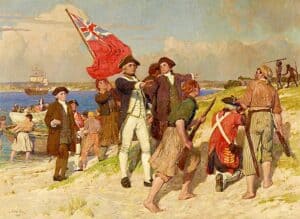
Cook's arrival in Botany Bay - Cook and his crew spent a week at Botany Bay gathering water, wood, fodder, and plant specimens while also exploring the surroundings. Cook attempted unsuccessfully to build relations with the Indigenous inhabitants.
- This first landing spot would eventually be advocated as a viable option for setting up a settlement and a British colonial outpost.
- He travelled northward after leaving Botany Bay. On 11 June 1770, the Endeavour ran aground on a reef shoal of the Great Barrier Reef. The ship was severely damaged, and his departure was delayed for over seven weeks while repairs were made on the beach. The Great Barrier Reef is considered one of the world's seven natural wonders and the world's largest coral reef system. It is visible from space and is the largest single structure made by living organisms.
- Cook returned to England via Batavia (modern Jakarta, Indonesia), where malaria claimed many of his crew members. The group eventually continued on its journey, arriving in London on 13 July 1771.
Second Voyage (1772–1775)
- Cook was promoted as a commander shortly after his return from the first expedition in August 1771.
- In 1772, he was commissioned by the Royal Society to organise another scientific trip in pursuit of the mythical Terra Australis again.
- Cook had shown on his first journey by circumnavigating New Zealand that it was not connected to a bigger landmass to the south.
- Despite the fact that he mapped practically the whole eastern coastline of Australia, demonstrating that it was continental in size, the other members of the Royal Society still believed that Terra Australis reside further south.
- To search for the Southern Continent, Cook was assigned command of the two ships, the Resolution and Adventure. HMS Resolution was commanded by Cook on this expedition, while HMS Adventure was commanded by Tobias Furneaux. The expedition set out from England on 13 July 1772 and made a supply stop at the Cape of Good Hope before continuing south.
- Cook and his crew arrived in Dusky Bay, New Zealand, on 26 May 1773. They spent the winter anchored in Ship Cove, touring inland and engaging with Maori people. After they left New Zealand in October 1773, the two ships were separated and were never reunited.
- The Adventure made its way back to England. Cook and the Resolution continued to explore numerous islands in the Pacific.
- The Resolution crossed the Antarctic Circle multiple times while travelling in the Pacific, sailing farther south than any other explorer at the time. The Antarctic Circle is the most southern of the five primary latitude circles that mark Earth's maps. The south region of this circle is referred to as the Antarctic.
- They got caught in sea ice several times. As a result, Cook decided to put the hunt for the Southern Continent on hold.
- They did not, however, return to England just yet. They travelled to Easter Island and spent seven months there, exploring and surveying the nearby Society Islands and Friendly Islands.
- The Resolution set out on her return voyage to England on 10 November 1774. En route, they circumnavigated South America's southernmost point and temporarily halted on the Sandwich Islands to reclaim them for England.
- On 30 July 1775, Cook made his way back to England and reported that the Southern Continent was nowhere to be discovered.
- Cook was promoted to post-captain and awarded an honorary retirement from the Royal Navy.
- He was appointed a Fellow of the Royal Society and received the Copley Gold Medal for finishing his second expedition without losing a single man to scurvy.
Third Voyage (1776–1779)
- Cook again commanded HMS Resolution on his final trip, while Captain Charles Clerke commanded HMS Discovery.
- The public was led to believe that the expedition was intended to return the Pacific Islander Omai (a young lad who became the second Pacific Islander to travel to Europe) to Tahiti.
- However, he primary purpose of the mission was to find a Northwest Passage around the American continent.
- On 12 July 1776, the ships set sail from England. They were forced to halt at Adventure Cove in Tasmania before continuing on to Ship Cove due to a storm. The men arrived on Christmas Island, today known as Kiritimati, in December 1777.
- They made an important discovery a few weeks later when they came across the Hawaiian islands.
- They arrived on modern-day Kauai and were captivated by the natural beauty and friendly natives. Yet Cook was still determined to find the Northwest Passage, so they set out two weeks later.
- They eventually arrived on modern-day Vancouver Island, where they socialised and traded with the locals.
- Cook continued his hunt for the Northwest Passage, commanding the expedition to sail northwest along what is now Alaska's coastline and through Prince William Sound.
- On 9 August 1778, they arrived at Alaska's westernmost point, which Cook named Cape Prince of Wales.
- Cook continued sailing into the Arctic Circle until he was stopped by a massive wall of ice.
- Cook and his troops sailed back down the Alaskan coast and south till they reached the Hawaiian Islands once more.
Death and Legacy
- In 1779, Cook returned to Hawaii. After travelling for eight weeks throughout the Hawaiian Archipelago, he made landing at Kealakekua Bay on Hawaii Island.
- They left Kealakekua Bay on 4 February 1779, but had to return a few days later because the Resolution was damaged in a storm.
- It has been hypothesised that the return of Cook's expedition to the islands was not only unexpected, but also unwanted by the Hawaiians.
- A group of Hawaiians stole one of Cook's longboats on 13 February 1779. Even with threats to fire upon them, the Hawaiian people had become "insolent" by that point. On 14 February, Cook attempted to kidnap and ransom the King of Hawaiʻi, Kalaniʻōpuʻu, in response to the theft.
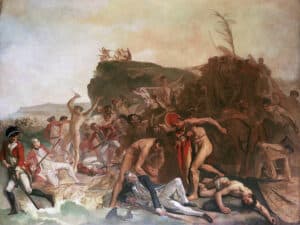
A painting depicting the death of Captain James Cook (Zoffany) - The Hawaiians stopped this by spotting Cook inviting King Kalanipuu to his ship on false pretenses. Hundreds of native Hawaiians came, some armed with weapons, and launched an aggressive pursuit, forcing Cook's soldiers to retreat to the shore.
- Cook was struck in the head by the villagers and then stabbed to death when he fell on his face in the surf as he turned his back to help launch the boats.
- The Hawaiians took his body away. Corporal James Thomas, Private Thomas Fatchett, Private Theophilus Hinks, and Private John Allen were also slain, while two others were injured in the clash.
- The Hawaiians prepared his body with burial procedures normally reserved for chiefs and the society's highest elders.
- Captain Charles Clerke took command of the mission and made one more attempt to cross the Bering Strait.
- On 22 August 1779, he died of tuberculosis, and John Gore seized command of the Resolution and the expedition.
- The expedition returned home, arriving in England in October 1780. After they arrived in England, James King finished Cook's account of the expedition.
- The third voyage's search was futile because neither a northwest nor a northeast channel accessible to sailing ships existed, and the journey resulted in Cook's death.
Marriage
- Cook's travels left him with little time for family life. Cook married Elizabeth Batts in 1762, when he was 34 years old, and spent more than half of their married lives at sea.
- The married couple had six children, three of whom died when they were young.
- The three surviving sons, two of whom had joined the navy, had all passed away by 1794.
Legacy
- Cook's 12 years of circumnavigation of the Pacific Ocean contributed significantly to Europeans' understanding of the area.
- Several islands, including the Hawaiian group, were discovered by Europeans for the first time, and his more accurate nautical mapping of vast parts of the Pacific was a significant accomplishment.
- Cook was able to circumnavigate the globe on his first journey without losing a single crew member to scurvy, a remarkable feat at the time. The most effective preventative intervention he examined was the frequent replacement of fresh meals.
- On his second journey, Cook utilised Larcum Kendall's K1 chronometer, which resembled a huge pocket watch and enabled him to determine his longitudinal location with far better precision.
- Cook was the first European to have considerable contact with various Pacific people. Despite vast ocean expanses separating them, he rightly proposed a relationship between all Pacific people.
- On his voyages, Cook carried several scientists who made important observations and discoveries.
- Many institutions, places, and landmarks were named after him to honour Cook's contributions.
Image Sources
- https://en.wikipedia.org/wiki/James_Cook#/media/File:Captainjamescookportrait.jpg
- https://en.wikipedia.org/wiki/First_voyage_of_James_Cook#/media/File:Cook'sFirstVoyage54.png
- https://en.wikipedia.org/wiki/First_voyage_of_James_Cook#/media/File:Landing_of_Lieutenant_James_Cook_at_Botany_Bay,_29_April_1770_(painting_by_E_Phillips_Fox).jpg
- https://en.wikipedia.org/wiki/The_Death_of_Captain_James_Cook_%28Zoffany%29#/media/File:Zoffany_Death_of_Captain_Cook.jpg

